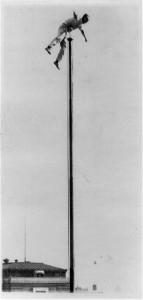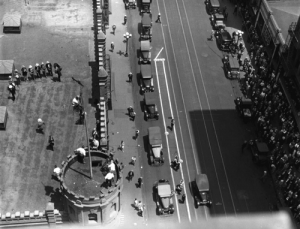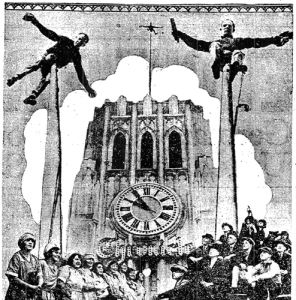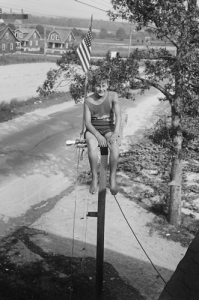Sitting atop the world…on a flagpole

We all know that flags fly from flagpoles. But, in the 1920s, flagpoles often came with something else attached: human beings!
How the Roaring Twenties’ fad of flagpole sitting began is lost to history, but many men, women and children called attention to themselves by climbing up poles and sitting there. And sometimes standing on their heads or shaving.
For example, a 1920 newspaper article reported how “John Reynolds, ‘human fly,’ attracted a large crowd to the vicinity [of a downtown hotel] when he…climbed to the top of the flag pole.” Once there, Reynolds “did numerous balancing stunts with chairs and other articles which…looked reckless.”
Two years later, Reynolds, who called himself “Daredevil Johnnie,” showed up in a Michigan town and eyed the flagpole atop the town’s courthouse. His goal was housekeeping: He had placed a new American flag there two years earlier and said it was time for a replacement.

One of the most renowned flagpole sitters was Alvin Kelly, known as Shipwreck Kelly because he said he had survived an accident at sea when he was a sailor. He seems to have preferred danger above the ground, rather than deep in the ocean.
His 1923 tour included a stop in San Francisco, where he clambered up a flagpole at the city’s newspaper building. For 13 hours, as thousands watched, he sat and then laid prone on the ornamental ball at the peak of the pole.

In an article in The Miami Herald in 1927, a jaded journalist termed flagpole-sitting “about the laziest occupation known to man….There he sits between heaven and earth for hour after hour, day after day. He doesn’t do a thing.” But Kelly inspired a Baltimore teen named Azey Foreman, who stayed atop a flagpole for ten days and became an instant national celebrity. The mayor praised Azey for his “grit and stamina.”
Kelly’s life, which he risked many times, didn’t end until 1952, when he was 67. His demise was prosaic: He collapsed on a New York City street while carrying some of his scrapbooks. His obituary in The New York Times ranked “his greatest feat” as the time in 1930 when he stayed on a flagpole in Atlantic City, N.J., for 49 days.

Five years after that, as he was balancing on a pole in the Bronx, the police sent a written message up to him. It was a summons and a notice that the era of flagpole sitting was ending. Kelly estimated that he had whiled away more than 20,000 pole hours in wind, snow and rain.
When police searched Kelly’s room after his death, they found more newspaper clippings and a duffel bag filled with ropes, the prosaic tools of his unusual profession.
